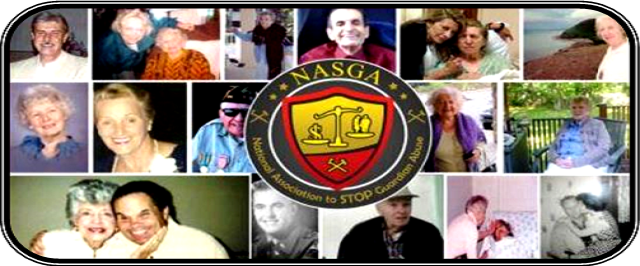Donna Navarrete used more than $8,000 of an 87-year-old man’s state pension to pay her own bills instead of his medical costs.
“They feel they can continue to endure (their current situation),” he said.
Rae J. Bosley spent $800 of a woman’s Social Security funds at a popular gambling destination in Colorado.
Lynne
M. Poole transferred $14,700 of her mother’s money to her and her
husband’s accounts, and was suspected of making unauthorized purchases
and ATM withdrawals of more than $20,000.
In recent
years, all three women were sentenced in Laramie County District Court
to first-offender probation and ordered to pay back tens of thousands of
dollars for abusing or exploiting vulnerable adults.
Their
cases are examples of what can happen when court-appointed guardians,
caretakers or family members with the wrong intentions have access to a
vulnerable person’s finances.
As our nation continues to
age, and many people choose to age at home, advocates are trying to call
attention to elder abuse -- a crime that seems to be increasing in
frequency.
“It’s absolutely escalating, and I think what
we’re finding is that people just aren’t educated about it,” Kristi
Skinner said last month during the Wyoming Conference on Aging.
Skinner recently became the program analyst for Adult Protective Services within the state’s Department of Family Services.
She said her task is going to be “getting out across the state and letting folks know: This is a problem.”
The
Wyoming Conference on Aging last month highlighted elder abuse as an
important issue, bringing in a California prosecutor who speaks
passionately about pursuing people who perpetrate crimes against older
individuals.
Laramie County District Attorney Jeremiah Sandburg said he feels the same.
“I
was really very close to my grandparents, so any time I see that
happening to anybody in society who’s a vulnerable adult, or potentially
so, I take that very seriously,” he said.
“If we’re not protecting the vulnerable people in our society, then what the heck are we here for?”
Dorothy Thomas has worked as the program analyst for Adult Protective Services within DFS for the past nine years.
She described abuse of vulnerable adults as a “silent epidemic.”
“It’s
family and caregivers who are perpetrating the crimes, which only makes
elders and vulnerable adults more fearful” or hesitant to report them,
she said.
Thomas compiled a report published in December
that outlines the monetary toll that financial exploitation of
vulnerable adults takes on state services.
National
researchers have estimated that as many as 44 cases of financial
exploitation go unreported for every case that is reported, according to
Thomas’ report.
Statewide, six substantiated cases of
financial exploitation of a vulnerable adult in 2013 cost seniors and/or
financial institutions $62,382.26, according to the report. The
potential cost to Medicaid for those six cases was $431,072.
Cases
are substantiated when the evidence gathered strongly suggests
exploitation occurred. DFS can substantiate cases independent of whether
criminal charges are ever filed.
Financially exploited
vulnerable adults in 2013 ranged in age from 28 to 92, with the average
age being 67, according to Thomas’ report.
The average financial loss per case that year was almost $10,400, with the largest amount stolen being $54,000.
In
2012, 16 victims ranged in age from 57 to 100, with the average age
being 78. Those cases cost seniors and/or financial institutions nearly
$790,000, and the potential cost to Medicaid that year was estimated to
be just over $266,000.
The average financial loss per case that year was more than $46,000, with the largest amount stolen being $170,000.
Thomas’
report notes that there continues to be a perception that financial
exploitation of vulnerable adults, especially by family members, is a
civil matter, rather than criminal.
“Prosecution on a criminal level may still be possible; if not for exploitation, then for fraud or larceny,” the report says.
Sandburg echoed that sentiment.
He
said it’s important for law enforcement and prosecutors to comb through
every fact of a case to properly determine whether the matter should be
pursued in civil or criminal court.
“We take these cases
very seriously, and so we do give them that hard look, and we make sure
to talk to all the interested parties,” he said.
“When
you take that hard look at it, there is a prosecutable event often times
that you wouldn’t find if you just looked at the affidavit or the
report.”
Prosecuting vulnerable adult abuse crimes can
presents challenges similar to those faced in pursuing child abuse or
domestic violence.
Victims often are reluctant to report their perpetrator because in many cases it’s a family member.
“Whether
it’s physical child abuse or spousal abuse or relative abuse or elderly
physical abuse, you have a victim that may or may not be cooperative –
that may or may not even be vocal,” Sandburg said.
He
continued: “You may have a person who’s afraid -- afraid of what’s going
to happen to them should the person that they are living with be taken
away or their ability to stay with them be taken away.”
A guilty verdict could turn a victim’s entire future upside down.
Questions
might run through his or her mind: “Am I going to lose my home? Am I
going to have to go into an assisted living facility?”
As
bad as things are in a victim’s current environment, the unknown can
make them fear prosecution to the point they don’t want to cooperate,
Sandburg explained.
Full Article & Source:
As elder abuse increases in Wyoming, officials work on educating public


No comments:
Post a Comment